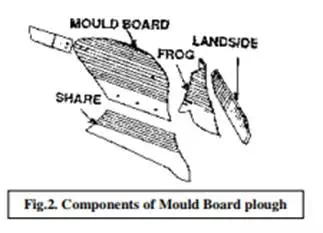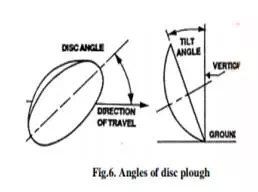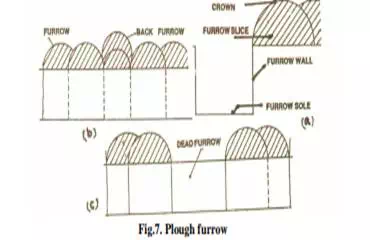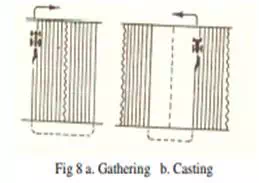Tillage and its Implements
Tillage
It is a mechanical manipulation of soil to provide favourable condition for crop production. Soil tillage consists of breaking the compact surface of earth to a certain depth and to loosen the soil mass, so as to enable the roots of the crops to penetrate and spread into the soil.
Objectives of Tillage
· To obtain deep seed bed, suitable for different type of crops.
· To add more humus and fertility to soil by covering the vegetation.
· To destroy and prevent weeds.
· To aerate the soil for proper growth of crops.
· To increase water-absorbing capacity of the soil.
· To destroy the insects, pests and their breeding places and
· To reduce the soil erosion.
Classification of Tillage
Primary tillage
It constitutes the initial major soil working operation. It is normally designed to reduce soil strength, cover plant materials and rearrange aggregates. The operations performed to open up any cultivable land with a view to prepare a seed bed for growing crops is known as primary tillage. Animal drawn implements mostly include indigenous plough and mould-board plough. Tractor drawn implements include mould-board plough, disc plough, subsoil plough, chisel plough and other similar implements.
Secondary tillage
Tillage operations following primary tillage those are performed to create proper soil tilth for seeding and planting are secondary tillage. These are lighter and finer operations, performed on the soil after primary tillage operations. Secondary tillage consists of conditioning the soil to meet the different tillage objectives of the farm. The implements include different types of harrow, cultivators, levellers, clod crushers etc.
Types of Tillage
Minimum Tillage –
It is the minimum soil manipulation necessary to meet tillage requirements for crop production.
Strip Tillage –
It is a tillage system in which only isolated bands of soil are tilled.
Rotary Tillage –
It is the tillage operations employing rotary action to cut, break and mix the soil.
Mulch Tillage –
It is the preparations of soil in such a way that plant residues or other mulching materials are specially left on or near the surface.
Combined Tillage –
Operations simultaneously utilizing two or more different types of tillage tools or implements to simplify, control or reduce the number of operations over a field are called combined tillage.
Difference between tools/Implements/Machines
Tool –
It is an individual working element such as disc or shovel.
Implement –
It is equipment generally having no driven moving parts, such as harrow or having only simple mechanism such as plough.
Machine –
It is a combination of rigid or resistant bodies having definite motions and capable of performing useful work.
Implements for Primary Tillage
Plough –
Ploughing is the primary tillage operations, which are performed to cut, break and invert the soil partially or completely. Ploughing essentially means opening the upper crust of the soil, breaking the clods and making the soil suitable for sowing seeds.
Country or Indigenous plough:
It penetrates into the soil and breaks it open. The functional components include share, body, shoe, handle and beam (fig 1). It can be used for dry land, garden land and wetland ploughing operations.
Share –
It is the working part of the plough attached to the shoe with which it penetrates into the soil and breaks it open.
Shoe –
It supports and stabilizes the plough at the required depth.
Body –
It is main part of the plough to which the shoe, beam and handle are generally attached. In country plough body and shoe are integral part.
Beam –
It is generally a long wooden piece, which connects the main body of the plough to the yoke.
Handle –
A wooden piece vertically attached to the body to enable the operator to control the plough.

Operational adjustments
a. Lowering or raising the beam with respect to the plough body, resulting in a change in the angle of the share with the horizontal plane to increase or decrease the depth of operation.
b. Changing the length of the beam (body to yoke on the beam) to increase or decrease the depth of operation.
c. The size of the plough is represented by the width of the body.
Mould board plough:
Function:
1) cutting the furrow slice
2) lifting the soil
3) turning the furrow slice and
4) pulverising the soil.
Components
M.B. plough consists of (Fig) Share, Mould board, Land side, Frog and Tail piece.
Share –
It penetrates into the soil and makes a horizontal cut below the soil surface. It is a sharp, well-polished and pointed component. The shares are made of chilled cast iron or steel. The steel mainly contains about 0.70 to 0.80% carbon and about 0.50 to 0.80% manganese besides another minor element

Mouldboard –
The mouldboard is that part of the plough which receives the furrow slice from the share. If lifts, turns and breaks the furrow slice. To suit different soil conditions and crop requirements, mouldboard has been designed in different shapes. The mouldboard is of following types: a) General purpose b) Stubble c) Sod or Breaker and d) Slat.
i) General purpose - It is a mouldboard having medium curvature lying between stubble and sod. The sloping of the surface is gradual. It turns the well-defined furrow slice and pulverises the soil thoroughly. It has a fairly long mouldboard with a gradual twist, the surface being slightly convex.
ii) Stubble type -It is short but broader mouldboard with a relatively abrupt curvature which lifts breaks and turns the furrow slice used in stubble soils. Its curvature is not gradual, but it is abrupt along the top edge. This causes the furrow slice to be thrown off quickly, pulverising it much better than other types of mouldboard. This is best suited to work in stubble soil that is under cultivation for years together. Stubble soil is that soil in which stubble of the plants from the previous crop is still left on the land at the time of ploughing

iii) Sod or Breaker type –
It is a long mouldboard with gentle curvature which lifts and inverts the unbroken furrow slice. It is used in tough soil of grasses. It turns over thickly covered soil. This is very useful where complete inversion of soil is required by the farmer
iv) Slat type –
It is a mouldboard whose surface is made of slats placed along the length of the mouldboard, so that there are gaps between the slats. This type of mouldboard is often used, where the soil is sticky, because the solid mouldboard does not scour well in sticky soils.
Land side –
It is the flat plate which bears against and transmits lateral thrust of the plough bottom to the furrow wall. It helps to resist the side pressure exerted by the furrow slice on the mouldboard. It also helps in stabilizing the plough while it is in operations.
Frog –
Frog is that part of the plough bottom to which the other components of the plough bottom are attached. It is an irregular piece of metal. It may be made of cast iron for cast iron ploughs or it may be welded steel for steel ploughs.
Tail piece –
It is an important extension of mouldboard which helps in turning a furrow slice.
Plough accessories
There are a few accessories necessary for plough such as (i) Jointer (ii) Coulter (iii) Gauge wheel (iv) Land wheel and (v) Furrow wheel.
Jointer –
It is a small irregular piece of metal having a shape similar to an ordinary plough bottom. It looks like a miniature plough. Its purpose is to turn over a small ribbon like furrow slice directly in front of the main plough bottom. This small furrow slice is cut from the left and upper side of the main furrow slice and is inverted so that all trashes on the top of the soil are completely turned down and buried under the right-hand corner of the furrow.
Coulter-
It is a device used to cut the furrow slice vertically from the land ahead of the plough bottom. It cuts the furrow slice from the land and leaves a clear wall. It also cuts trashes which are covered under the soil by the plough. The coulter may be (a) Rolling type disc coulter or (b) Sliding type knife coulter.
Gauge wheel-
It is an auxiliary wheel of an implement to maintain uniform depth of working. Gauge wheel helps to maintain uniformity in respect of depth of ploughing in different soil conditions. It is usually placed in hanging position.
Land wheel –
It is the wheel of the plough, which runs on the ploughed land.
Front furrow wheel –
It is the front wheel of the plough, which runs in the furrow.
Rear furrow wheel –
It is the rear wheel of the plough, which runs in the furrow.
Adjustment of mouldboard plough
Vertical suction (Vertical clearance)
It is the maximum clearance under the land side and the horizontal surface when the plough is resting on a horizontal surface in the working position. It is the vertical distance from the ground, measured at the joining point of share and land side. (Fig.4). It helps the plough to penetrate into the soil to a proper depth. This clearance varies according to the size of the plough.

Horizontal suction (Horizontal clearance)
It is the maximum clearance between the land side and a horizontal plant touching point of share at its gunnel side and heal of land side (Fig). This suction helps the plough to cut the proper width of furrow slice. This clearance varies according to the size of the plough. It is also known as side clearance.
Throat clearance
It is the perpendicular distance between point of share and lower position of the beam of the plough.
Plough size
The size of the mouldboard plough is expressed by width of cut of the soil
Disc Plough:
It is a plough, which cuts, turns and in some cases breaks furrow slices by means of separately mounted large steel discs. A disc plough is designed with a view of reduce friction by making a rolling plough bottom instead of sliding plough bottom. A disc plough works well in the conditions where mould board plough does not work satisfactorily.
advantages of disc plough
♦ A disc plough can be forced to penetrate into the soil which is too hard and dry for working with a mould board plough.
♦ It works well in sticky soil in which a mould board plough does not scour.
♦ It is more useful for deep ploughing
♦ It can be used safely in stony and stumpy soil without much danger of breakage.
♦ A disc plough works well even after a considerable part of the disc is worn off in abrasive soil.
♦ It works in loose soil also (such as peat) without much clogging.
Disadvantages of disc plough
♦ It is not suitable for covering surface trash and weeds as effectively as mouldboard plough does.
♦ Comparatively, the disc plough leaves the soil in rough and more cloddy condition than that of mouldboard plough.
♦ Disc plough is much heavier than mouldboard plough for equal capacities because penetration of this plough is affected largely by its weight rather than suction. There is one significant difference between mouldboard plough and disc plough i.e. mouldboard plough is forced into the ground by the suction of the plough, while the disc plough is forced into the ground by its own weight.
Types of Disc Plough
Disc ploughs are of two types
(a) Standard disc plough and
(ii) Vertical disc plough.
(i) Standard disc plough
It consists of steel disc of 60 to 90 cm diameter, set at a certain angle to the direction of travel. Each disc revolves on a stub axle in a thrust bearing, carried at the lower end of a strong stand which is bolted to the plough beam. The angle of the disc to the vertical and to the furrow wall is adjustable. In action, the disc cuts the soil, breaks it and pushes it sideways. There is little inversion of furrow slice as well as little burying of weeds and trashes. The disc plough may be mounted type or trailed type. In mounted disc plough, the side thrust is taken by the wheels of the tractor. Disc is made of heat treated steel of 5 mm to 10 mm thickness. The amount of concavity varies with the diameter of the disc. The approximate values being 8 cm for 60 cm diameter disc and 16 cm for 95 cm diameter. A few important terms connected with disc plough is explained below

Disc –
It is a circular, concave revolving steel plate used for cutting and inverting the soil.
Disc angle –
It is the angle at which the plane of the cutting edge of the disc is inclined to the direction of travel. Usually the disc angle of good plough varies between 42° to 45°.
Tilt angle –
It is the angle at which the plane of the cutting edge of the disc is inclined to a vertical line. The tilt angle varies from 15° to 25° for a good plough.
Scraper –
It is a device to remove soil that tend to stick to the working surface of a disc.

Concavity –
It is the depth measured at the centre of the disc by placing its concave side on a flat surface.
(i) Vertical Disc Plough
It is the plough which combines the principle of regular disc plough and disc harrow and is used for shallow working in the soil.
Draft of disc plough
The disc plough is lighter in draft than the mouldboard plough, turning same volume of soil in similar conditions. In very hard soil, some extra weight is added to the wheel which increases the draft.
Rotary tiller
The rotary cultivator is widely considered to be the most important tool as it provides fine degree of pulverization enabling the necessary rapid and intimate mixing of soil besides reduction in traction demanded by the tractor driving wheels due to the ability of the soil working blades to provide some forward thrust to the cultivating outfit. Rotary tiller is directly mounted to the tractor with the help of three-point linkage. The power is transmitted from the tractor PTO (Power Take Off) shaft to a bevel gear box mounted on the top of the unit, through telescopic shaft and universal joint. From the bevel gear box, the drive is further transmitted to a power shaft, chain and sprocket transmission system to the rotor. The tynes are fixed to the rotor and the rotor with tynes revolves in the same direction as the tractor wheels. The number of tynes varies from 28 - 54. A levelling board is attached to the rear side of the unit for levelling the tilled soil. A depth control lever with depth wheel provided on either side of the unit ensures proper depth control. The following types of blades are used with the rotor.
i. 'L' type blade - Works well in trashy conditions, they are more effective in cutting weeds and they do not pulverize the soil much.
ii. Twisted blade - Suitable for deep tillage in relatively clean ground but clogging and wrapping of trashes on the tynes and shafts.
iii. Straight blade - Employed on mulchers designed mainly for secondary tillage.
Chisel plough
Chisel ploughs are used to break through and shatter compacted or otherwise impermeable soil layers. Deep tillage shatters compacted sub soil layers and aids in better infiltration and storage of rainwater in the crop root zone. The improved soil structure also results in better development of root system and the yield of crops and their drought tolerance is also improved. The functional component of the unit includes reversible share, Tyne (chisel), beam, cross shaft and top link connection.
Sub-Soil plough
The function of the sub-soiler is to penetrate deeper than the conventional cultivation machinery and break up the layers of the soil, which have become compacted due to the movement of heavy machinery or as a result of continuous ploughing at a constant depth. These compacted areas prevent the natural drainage of the soil and also inhibit the passage of air and nutrients through the soil structure. The sub-soiler consists of heavier Tyne than the chisel plough to break through impervious layer shattering the sub-soil to a depth of 45 to 75 cm and requires 60 to 100 hp to operate it. The advantages are same as that of chisel plough.
Ploughing System
Normal Ploughing:
It is the ploughing up to a depth of about 15 cm.
Contour Ploughing:
It is the method of ploughing in which the soil broken and turned along the contours.
Ploughing of Land
The ploughing of land separates the top layer of soil into furrow slices. The furrows are turned sideways and inverted to a varying degree, depending upon the type of plough being used. It is a primary tillage operation, which is performed to shatter soil uniformly with partial or complete soil inversion. There are a few important terms frequently used in connection with ploughing of land.

(b) Furrow –
It is a trench formed by an implement in the soil during the field operation (Fig.7a).
(i) Furrow slice –
The mass of soil cut, lifted and thrown to one side is called furrow slice.
(ii) Furrow wall –
It is an undisturbed soil surface by the side of a furrow.
(iii) Crown –
The top portion of the turned furrow slice is called crown.
(iv) Back furrow –
A raised ridge left at the centre of the strip of land when ploughing is started from centre to side is called back furrow. When the ploughing is started in the middle of a field, furrow is collected across the field and while returning trip another furrow slice is lapped over the first furrow. This is the raised ridge which is named as back furrow (Fig.7b ).
(v) Dead furrow –
An open trench left in between two adjacent strips of land after finishing the ploughing is called dead furrow (Fig.7c).
(vi) Head land -
While ploughing with a tractor to turn, a strip of un ploughed land is left at each end of the field for the tractor to turn, that is called head land. At the end of each trop, the plough is lifted until the tractor and the plough have turned and are in position to start the return trip. The head land is about 6 metres for two or three bottom tractor plough and one metre more for each additional furrow.
Methods of ploughing
In order to provide furrows at all times on the right-hand side of the plough two method of working are used a) Gathering b) Casting.

a) Gathering –
Whenever a plough works round a strip of ploughed land, it is said to be gathering.
b) Casting –
Whenever a plough works round a strip of unploughed land, it is said to be casting.
Ploughing of a field by casting or gathering alone is normally uneconomical. The following are a few important methods used in tractor ploughing.
i) Continuous ploughing method and
ii) Round and round ploughing
Terminology of plough
Centre of power
It is the true point of hitch of a tractor.
Centre of resistance
It is the point at which the resultant of all the horizontal and vertical forces act. The centre lies at a distance equal to 3/4th size of the plough from the share wing.
Line of pull
It is an imaginary straight line passing from the centre of resistance through the clevis to the centre of pull (power).
Pull
It is the total force required to pull an implement.
Draft
It is the horizontal component of the pull, parallel to the line of motion
D = P cos θ where D is draft (kgf) and P = pull in (kgf)
θ = angle between line of pull and horizontal.
HP = Draft (kgf) X Speed (m s)/ 75
Draft depends upon 1) sharpness of cutting edge 2) working speed 3) working width 4) working depth 5) type of implement 6) soil condition and 7) attachments.
Side draft
It is the horizontal component of the pull perpendicular to the direction of motion. This is developed if the centre of resistance is not directly behind the centre of pull.
Unit draft
It is the draft per unit cross sectional area of the furrow.
Theoretical field capacity
It is the rate of field coverage of the implement, based on 100 per cent of time at the rated speed and covering 100 per cent of its rated width.
TFC, ha h = w x s / 10
Effective field capacity
It is the actual area covered by the implement based on its total time consumed and its width.
C=S x W /10 x E/100
Where
C = effective field capacity, hectare per h.
S = speed of travel in km per hour.
W = theoretical width of cut of the machine in metre, and
E = field efficiency in percent.
Field efficiency
It is the ratio of effective field capacity and theoretical field capacity expressed in percent.
Field Efficiency = EFC / TFC x 100
Soil pulverization
It is the quality of work in terms of soil aggregates and clod size. This is measured by cone penetrometer